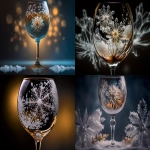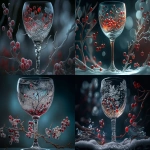Explore the Best AI Image Gallery

Quantum Creativity: Where Computing Meets the Artistic Imagination
The realm of creativity is on the cusp of a profound transformation, driven by the unprecedented power of quantum computing. This revolutionary technology, capable of processing information in ways unimaginable with classical computers, holds the potential to unlock new dimensions of artistic expression, design, and innovation.
Quantum Leap in Artistic Expression
Imagine artists wielding quantum algorithms to generate mesmerizing patterns, compose symphonies that evoke complex emotions, or sculpt virtual worlds that defy the limitations of physical space. Quantum computing empowers creators with tools to explore uncharted territories of artistic expression, pushing the boundaries of imagination and perception.
Quantum Design: A Paradigm Shift
The design industry stands to benefit immensely from quantum computings ability to analyze vast datasets and identify intricate patterns. Architects could leverage quantum algorithms to optimize building designs for energy efficiency and structural integrity. Fashion designers could utilize quantum simulations to predict trends and create garments that adapt to individual body shapes and movements.
Beyond Aesthetics: Quantum Creativity in Action
The applications of quantum creativity extend far beyond aesthetics. Consider these examples:
- Interactive Storytelling: Quantum algorithms could power immersive narratives that adapt to user choices, creating truly personalized and engaging storytelling experiences.
- Generative Music Composition: Imagine AI-powered music generators fueled by quantum computing, capable of composing original scores in diverse genres and styles, pushing the boundaries of musical innovation.
- Quantum-Enhanced Filmmaking: Quantum simulations could revolutionize special effects and animation, allowing filmmakers to create breathtakingly realistic virtual worlds and characters.
Navigating Ethical Considerations
As with any powerful technology, quantum computing raises ethical considerations that must be addressed thoughtfully.
- Bias in Algorithms: Quantum algorithms trained on biased data could perpetuate existing societal inequalities in creative fields.
- Ownership and Copyright: The question of authorship arises when AI systems powered by quantum computing generate creative content.
- Accessibility and Equity: Ensuring that the benefits of quantum creativity are accessible to all individuals, regardless of their socioeconomic background or technical expertise, is crucial.
The Future of Quantum Creativity
The future of quantum creativity is brimming with possibilities. As research progresses and quantum technology becomes more accessible, we can expect to witness a surge in innovative applications that blur the lines between art, science, and technology.
From immersive experiences that transport us to new realities to AI-powered creative tools that empower artists of all levels, quantum computing is poised to redefine the very essence of creativity, ushering in an era of unprecedented artistic expression.




